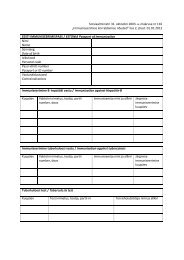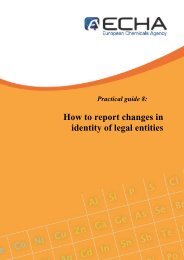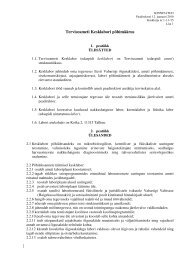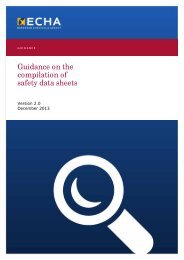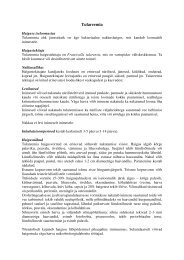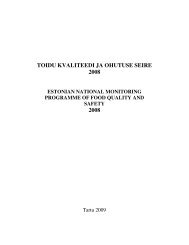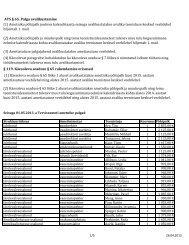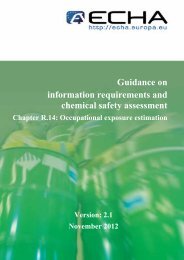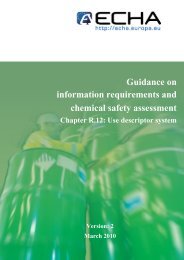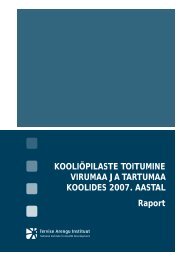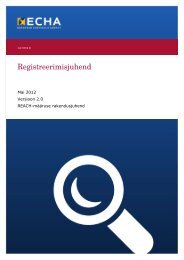Guidance for monomers and polymers - ECHA - Europa
Guidance for monomers and polymers - ECHA - Europa
Guidance for monomers and polymers - ECHA - Europa
Create successful ePaper yourself
Turn your PDF publications into a flip-book with our unique Google optimized e-Paper software.
22<br />
<strong>Guidance</strong> <strong>for</strong> <strong>monomers</strong> <strong>and</strong> <strong>polymers</strong><br />
Version 2.0 April 2012<br />
For further in<strong>for</strong>mation on notification requirement in accordance with the CLP Regulation,<br />
please refer to Practical guide no.7, available on the <strong>ECHA</strong> website.<br />
3.2.5 In<strong>for</strong>mation down the supply chain<br />
The manufacturer or importer of a polymer must provide his customer(s) with a safety data<br />
sheet (SDS) <strong>for</strong> the polymer if this polymer substance meets the criteria <strong>for</strong> classification as<br />
dangerous, PBT or vPvB or if it is listed in the c<strong>and</strong>idate list of substances to be subject to<br />
authorisation (Article 31). According to Article 32, if the SDS is not required but the polymer is<br />
subject to either authorisation or restriction, or if relevant in<strong>for</strong>mation about the polymer<br />
necessary to enable appropriate risk management is available, the supplier must nonetheless<br />
provide that in<strong>for</strong>mation to his customer(s), together with details of any eventual authorisation<br />
granted or denied in his supply chain.<br />
In either case, the in<strong>for</strong>mation in the supply chain, where relevant, needs to take into account<br />
the in<strong>for</strong>mation generated on the monomer substance or any other component substance. This<br />
should in particular take into consideration the presence of unreacted monomer.<br />
Example 4 : Example on the identification of the monomer substances <strong>and</strong> other<br />
substances to be registered by an importer of polymer<br />
Company X established in the Community intends to import 50 tonnes per year of a resin<br />
manufactured from ethylene oxide, propylene oxide <strong>and</strong> glycerol. The substance has the<br />
following composition:<br />
2.0 wt% of glycerol chemically bound to the polymer<br />
70.0 wt% of polymerised ethylene oxide<br />
25.5 wt% of polymerised propylene oxide<br />
2.5 wt% unreacted glycerol<br />
The structure of the polymer molecules is depicted in Figure 4.<br />
R2<br />
R1<br />
O<br />
O<br />
y<br />
H<br />
H<br />
O<br />
x<br />
O<br />
R3<br />
O<br />
O<br />
z<br />
H<br />
Figure 4: One representation of the general structure of the reaction product from<br />
glycerol, ethylene oxide <strong>and</strong> propylene oxide (x, y <strong>and</strong> z are integers, R1, R2 <strong>and</strong> R3<br />
are H atoms or methyl groups).<br />
Ethylene oxide <strong>and</strong> propylene oxide are both <strong>monomers</strong>, while glycerol acts as the initiator of<br />
the reaction <strong>and</strong> there<strong>for</strong>e is considered as an "other reactant".<br />
Annankatu 18, P.O. Box 400, FI-00121 Helsinki, Finl<strong>and</strong> | Tel. +358 9 686180 | Fax +358 9 68618210 | echa.europa.eu




